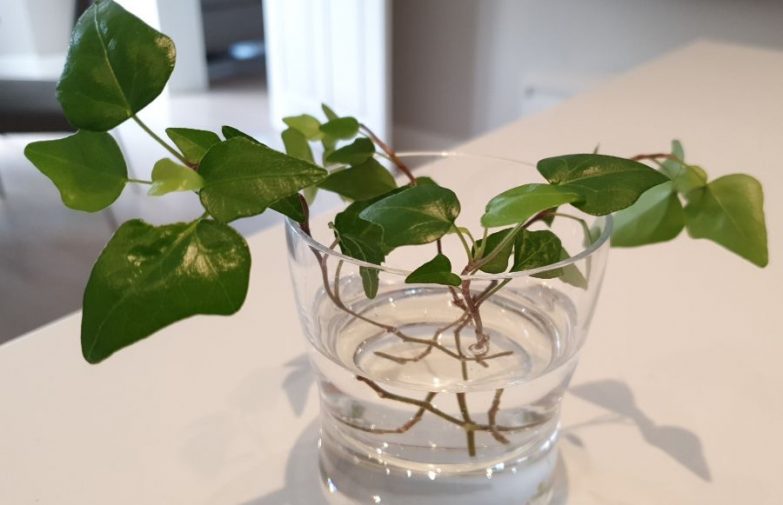Ivy, English Ivy, or Hedera helix, is not only a great houseplant for beginners and experienced gardeners alike, but it is also easy to propagate in water. Even if you are new to growing houseplants, or a beginner at propagation, you can learn how to propagate Ivy in water successfully. With a few simple steps, you’ll be on your way to growing more ivy plants for your home, garden, and friends.
If you want to propagate ivy in water successfully, the steps are very simple.
- Take several good cuttings with sterile pruners
- Strip away the bottom leaves, leaving some nodes behind.
- Place the ivy in water.
- Leave in bright, indirect light and temperatures of 65-80°F (18-27°C) for 4-6 weeks.
- Transplant the cuttings to soil when the roots grow to about two inches long.
How To Propagate Ivy In Water
Keep reading to learn more detailed information about the practical steps you need to follow to learn how to propagate ivy in water. You’ll learn what tools you need, what to expect when propagating ivy, and how to deal with any problems you may encounter.
If you’d like to learn how to propagate and grow all kinds of beautiful houseplants that thrive year after year, check out my book, “Houseplants Made Easy”.
How Difficult Is It To Propagate Ivy In Water
Propagating ivy in water is actually very easy and simple. You don’t need a lot of tools, just some ivy cuttings, a container, and a little water to put them in. Ivy is considered an invasive species in some states because of its natural ability to grow and thrive, which means it should grow very easily when given proper care.
Supplies Needed to Propagate Ivy In Water
- Shears or knife
- Container
- Water
- Ivy plants to propagate
How To Prepare Your Ivy Cuttings For Propagation
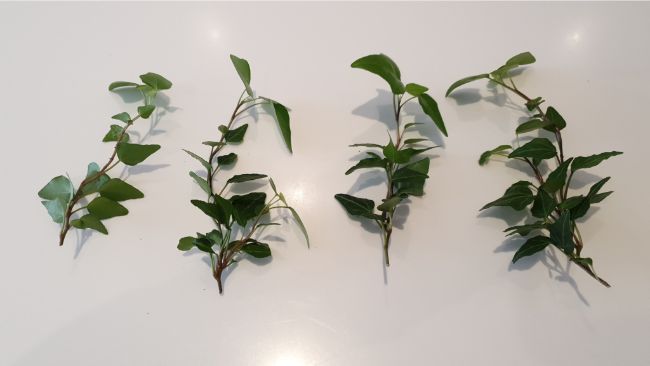
The most critical piece of propagating ivy is the cutting or cuttings that you will use. You will want to take several cuttings off of a healthy ivy plant. It is always better to have more cuttings than you think you will need in case some fail.
When propagating ivy in water, you always want to choose a healthy plant to start. Never try to propagate a plant that is sick, dying, or bug infested because this will increase the chances that your propagation will fail.
You will also want to choose new growth. In other words, use ivy cuttings from vines that are of the most recent year’s growth. Look for lighter colored leaves, which indicate newer growth, as opposed to older, darker colored leaves, which indicate older vines.
Also, look for stems that are in good shape but not too woody. A tough, woody stem is harder to propagate, although it is still possible if that is all you have available.
Using a sharp, clean knife or shears, clip the ivy off, creating sections that are around 4-6 inches long and have several leaves. It’s preferable to choose vines that already have nodes, but if not that’s ok because you can ‘create’ them. Try not to saw away at the ivy or tear it. Just make a clean, sharp cut.
It’s ok to take long vines and clip them into shorter segments. It’s also ok to propagate longer sections of ivy, but 4-6 inches is an ideal length and is also easier to work with when you are propagating ivy in water.
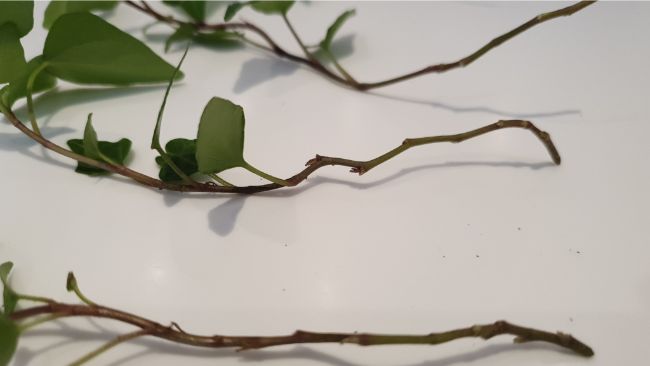
After you have clipped off your sections into the desired lengths, look for any nodes that may be available. A node is a little bump on the stem of the plant where stems, leaves, or even roots may grow from.
If you have nodes available, these are the best way to propagate. Just strip off the leaves around the nodes and submerge those nodes when you place the clipping in water. Roots will grow right out of the nodes.
However, if you don’t have any visible nodes on your ivy clipping, that is ok. You can ‘create’ your own nodes by carefully clipping off the bottom two inches of leaves. The sites where you have removed the leaves will act as nodes. Make sure this part is submerged when you place the clipping in water.
The last option for creating clippings is to wound the plant. After stripping the bottom two inches of leaves from your cutting, use your shears or knife to carefully peel back a little bit of the outer part of the stem. This will create a wound that the plant will use to grow new roots after it has been placed in water.
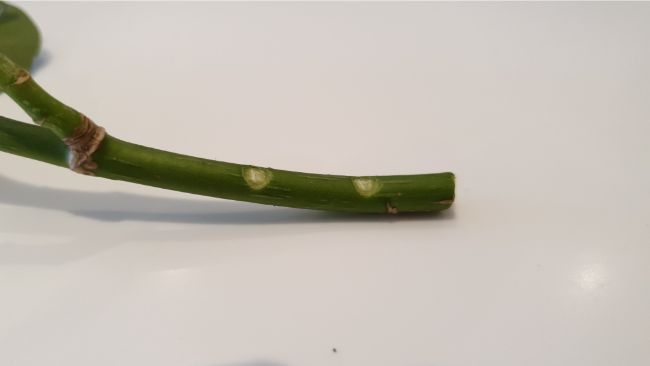
Ivy plants are so hardy that even if you simply place a cut off piece of ivy in water, it will probably grow. However, if you are serious about propagating ivy, it certainly helps to take the proper steps mentioned above to make sure you have the best chances of successfully propagating ivy.
Place your clipping into a container of water and place it in a bright window. Change the water every other week unless it looks dirty. If the water seems to be dirty, you can change it weekly, but don’t disturb the plant if it isn’t needed. Do make sure you top off the water regularly to keep the nodes of the stem completely submerged so that the roots will begin to grow.
How Long Does It Take To Propagate Ivy In Water
Ivy is hardy and fast growing. When the cuttings have been prepared properly, your ivy should propagate very quickly. There should be roots growing within three weeks, and your ivy should be ready to transplant within four to six weeks.
What Conditions Should You Put The Ivy Cutting In
A bright window is a great place to keep your ivy plant while it is growing roots. However, ivy does not direct sun or too much heat, so you may need to experiment to find a spot that is bright but won’t cook the plant.
You can use just about any kind of container to propagate your ivy in. It will need to hold water, of course, but other than that, you can choose just about anything you like. Clear glass containers such as vases or mason jars work well because you can see the roots as they grow. You’ll be able to tell when it is time to move your ivy to soil without disturbing the plant too soon.
When you are ready to move your ivy to soil, you will want to choose a quality potting soil that is designed for house plants. See my guide to choosing and making potting soil. Use a pot that has a drainage hole in the bottom so the soil doesn’t get too soggy. Keep the soil slightly damp until the roots are well-established, then water only when the soil becomes dry.
When Should You Move The Ivy From Water To Soil
Once your ivy is growing roots, you may be wondering when to move it from water to soil. There’s no need to rush, really. You can leave your ivy in the water for as long as you like and it should be just fine.
However, if you do leave them in water, the plants might not grow and thrive as well as they would in soil, so eventually you’ll probably want to plant them in good potting soil.
A good rule of thumb is to move your ivy to soil when the roots are about two inches long. Longer roots will help the plant establish itself in the soil better, but generally once the roots are two inches long you can be fairly assured that the new cutting will thrive. As long as you leave a few inches of roots, your ivy should be fine because it is hardy and easy to grow.
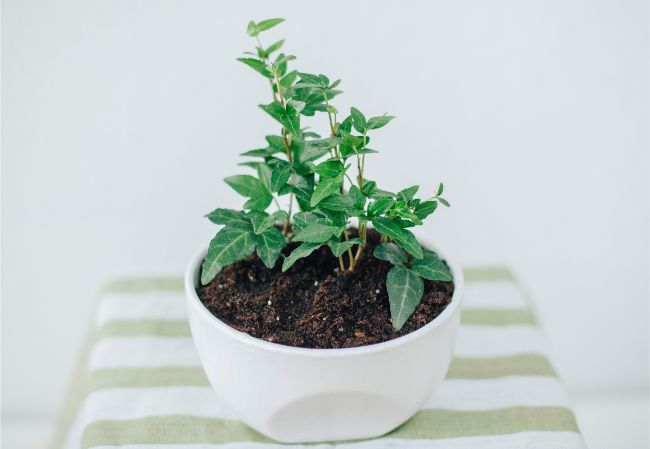
What Could Go Wrong When Propagating Ivy In Water
While propagating ivy in water is a very simple and easy process, things can still go wrong. To prevent problems, make sure your ivy always has enough water and that the water isn’t foul or smelly.
If you begin to suspect something is going wrong, ask yourself if the plant is growing and healthy? If it continues to grow while it is submerged in water, your plant should be ok even if the roots are slow to grow.
If the water becomes foul too quickly, or the plant seems to be rotting, check to see if all of the leaves below the water line have been removed. Leaves left in the water can rot and decay, causing the water to grow bacteria that are harmful to the plant itself.
Make sure your ivy is getting enough light but not too much direct sunlight. Too much sunlight can scorch your plant, causing it to die. If your plant looks like it is becoming scorched, move it out of direct sunlight or away from the grow light.
Too little sunlight will cause the plant to become spindly and pale. If this is the case, try moving it closer to a window or grow light so that it can receive more light to grow.
If your plant is wilting, make sure it has enough water to cover the wounded area or the nodes of the plant. If not, make sure you top the water off regularly so that it doesn’t fail.
Sometimes, propagation fails for no obvious reasons. It’s always better to propagate more cuttings than you need, just in case one or more fail. However, ivy is hardy and persistent, making it a great choice for beginners learning to propagate plants.

